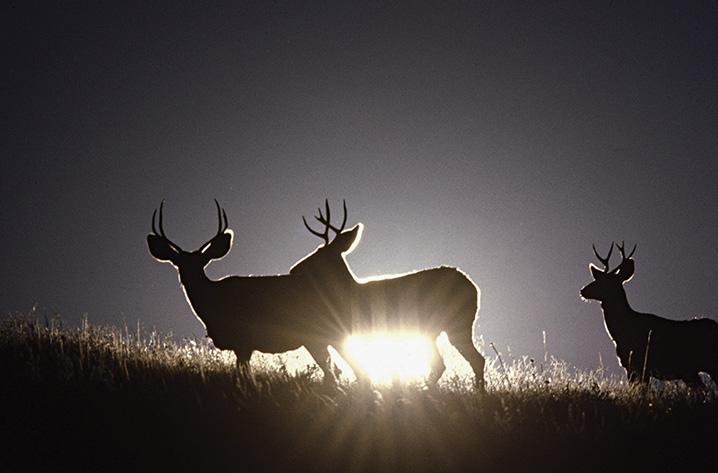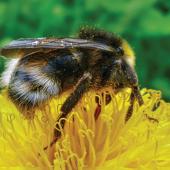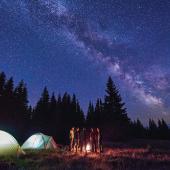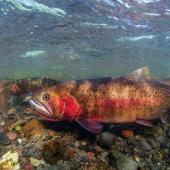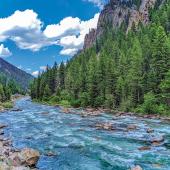Dark Side of the Mule
A grim future for the big-eared ungulate.
In his 1990 publication Mule Deer Country, Valerius Geist writes, “For all its current abundance, the mule deer, so different, so uniquely American, so young and promising, is nevertheless a species marked for extinction.”
Geist, a Canadian biologist, has written about whitetails, elk, moose, antelope, buffalo, and mountain sheep, and helped pen The North American Model of Wildlife Conservation, released in 2019. His journal on mule deer chronicles the species’ evolution as a hybrid derived from a whitetail–blacktail cross sometime around 10,000 years ago. Whitetails are a much older species, their first fossil-record appearance coming as early as 3.5 million years ago. While the genetic makeup of the two species is remarkably similar, they have obvious differences—one being that the future of mule deer looks a lot bleaker.
In the U.S., there are around 35 million whitetails and about four million mule deer. At first glance, that may not seem like a bad number for muleys, especially in Montana with herds prospering in the eastern part of the state. But let’s take a broader look at some ecological factors that are essential for mule-deer survival.
Like whitetails, mule deer are opportunists who eat browse and forbs. However, they prefer more remote areas less impacted by humans. Come summertime, they’ll move up to the high country where rich forage is still readily available. Whitetails, on the other hand, have never really shared that migration pattern, and throughout time have adapted quite well to human’s urban sprawl.
That mule deer share the same habitat as elk is another concern. Deer don’t need to eat as much as elk, but the wapiti are much better browsers in snow. And elk are generalists—they eat a wider variety of vegetation. Forage competition between the two species is becoming an increasing problem with real numbers to show for it. We’re seeing it in the Pioneers and Snowies right now. Since the 1980s, mule-deer populations have dropped over 50 percent in these ranges, with elk showing steady increases.
You’d think in a place like Montana we’d have more than enough space for all three of these fauna, but human development and fire-suppression have proved detrimental for the mule deer. New plants and shrubs are the first vegetation to pop up after a fire. With expanding conifer forests, areas that reliably provide quality forage are becoming quite limited.
These hurdles—very real for the mule deer—do not seem to slow the whitetail one bit. In fact, their range is expanding in most areas. Just ask anyone who grew up in the Gallatin Valley in the 1950s. I imagine they don’t remember seeing so many along the river, much less up Bear Canyon or high drainages in the Bridgers.
Whitetails are hosts for parasites that can be deadly if passed to other cervids. Take the meningeal brain worm, for example. Whitetails are the bug’s normal hosts, but they usually carry it unaffected—most likely an adaptive result of its long lifespan. Though if the disease is transmitted to moose, elk, caribou, or mule deer, it is almost always fatal.
Whitetails have proven themselves resilient—they’ve been around for millions of years. As ancient beings, they’ve survived climactic turmoil and mass extinction. In comparison, mule deer are just getting their feet under them. At the time of their initial evolution, most megafauna had been recently wiped out, including predators. It was an opportunistic time to come into the world, and life was relatively easy. And while they’ve done a decent job adapting to predators, humans, and other ungulates, their long-term outlook is questionable at best.
This is not to say mule deer are on the brink of annihilation; Helena is actually dealing with urban mule-deer conflicts right now. The impending issue, however, is coexistence with whitetails, humans, and other competing species. Earth is filling up, and Montana is no exception. For many years, mule deer flourished alongside the whitetail, from the prairies of Manitoba to the deserts of Arizona. But since humans started making our colossal footprint all over the West, it now appears that wherever the two species meet, Fortuna’s pick of natural selection goes to the ancestor.



